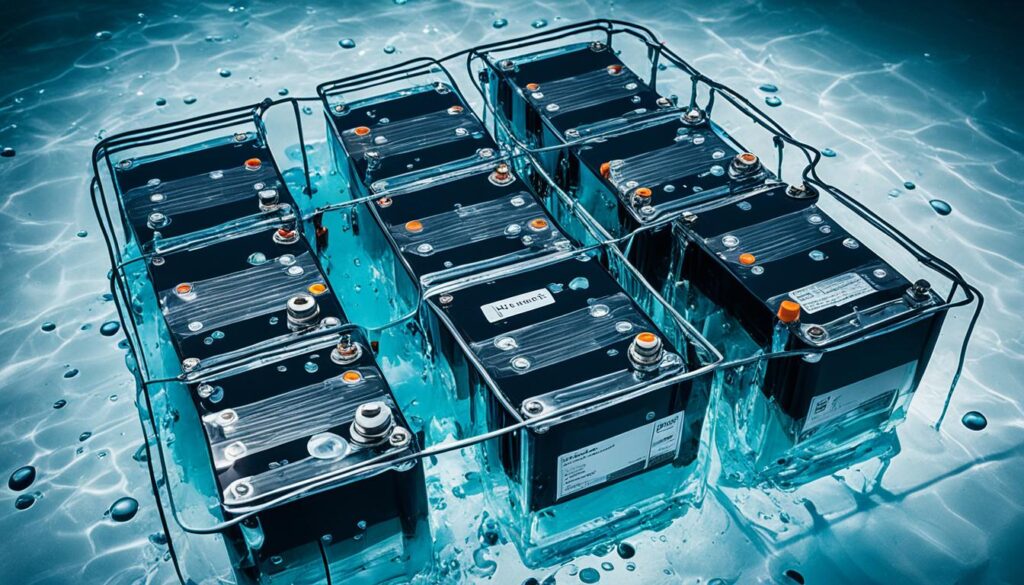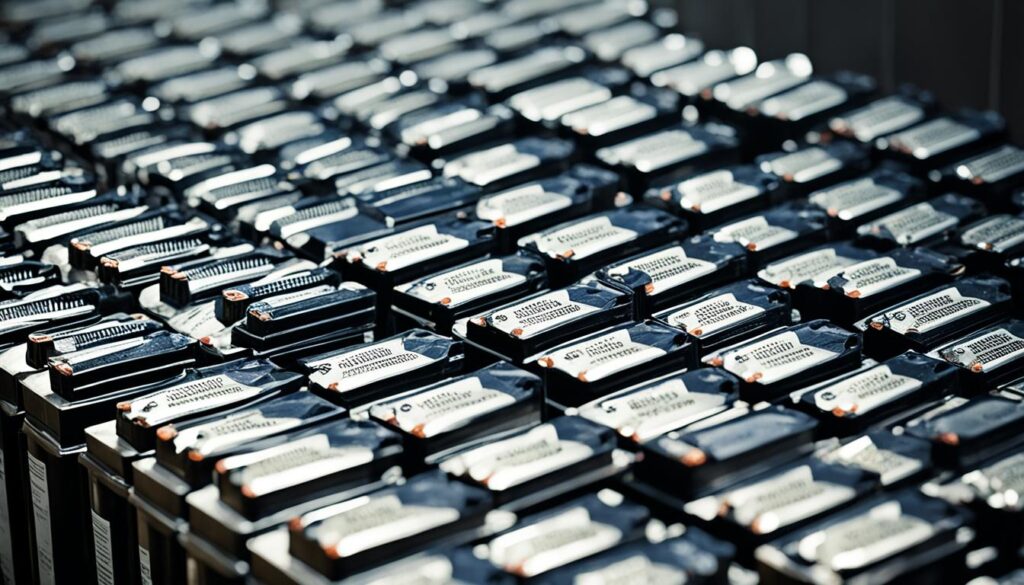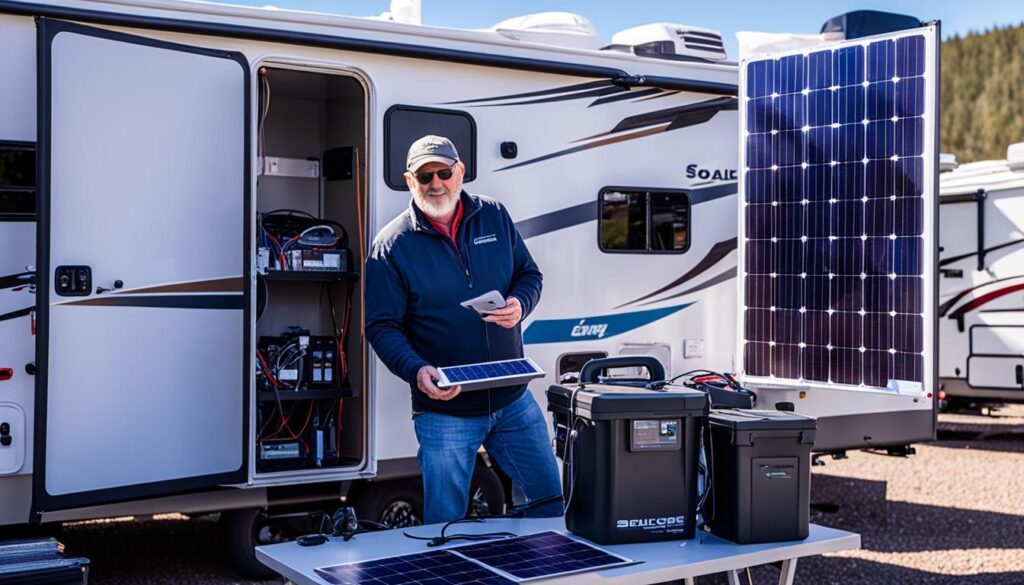RV batteries are the lifeblood of your RV’s electrical systems. But how do you ensure that your battery stays charged and ready to power your adventures, especially when your RV is in storage? Properly charging, maintaining, and storing your RV battery is key to maximizing its longevity and functionality.
In this article, I will guide you through the best practices for RV battery maintenance and storage, covering different types of RV batteries, including flooded lead-acid, sealed lead-acid, and lithium-ion batteries. Whether you’re a seasoned RVer or just starting out, understanding how to properly care for your RV battery is essential knowledge.
Key Takeaways:
- Regularly charge your RV battery to maintain its performance.
- Monitor and maintain proper electrolyte levels for flooded lead-acid batteries.
- Sealed lead-acid batteries offer a maintenance-free option for RVers.
- Lithium-ion batteries are low-maintenance and have a longer lifespan.
- Clean and maintain your RV battery regularly to ensure optimal performance and lifespan.
Contents
Lead-Acid Batteries: Maintenance and Storage
The most common type of battery used in trailers is the flooded lead-acid (FLA) wet-cell battery. These batteries require regular maintenance and proper storage to ensure optimal performance.
Due to the potential for off-gassing, flooded batteries need to be stored in a well-ventilated compartment or a sealed battery box with an external vent. This allows the release of any gases that may be generated during charging and discharging processes. Proper battery ventilation is essential for safety and to prevent the accumulation of potentially harmful gases.

In addition to battery ventilation, monitoring and maintaining proper electrolyte levels is crucial for flooded lead-acid batteries. Electrolyte is a mixture of sulfuric acid and water, and over time, water may evaporate, causing the electrolyte levels to drop. Regularly adding distilled water to the battery can help maintain the appropriate electrolyte levels and prevent damage due to insufficient electrolyte. It’s important to note that distilled water should be used as tap water may contain impurities that can affect battery performance.
“Proper battery ventilation and monitoring electrolyte levels are crucial for maintaining the performance and lifespan of flooded lead-acid batteries.”
When considering flooded lead-acid batteries, it’s also important to understand battery capacity. Battery capacity refers to the amount of energy a battery can store and deliver. In the case of deep-cycle batteries, which are commonly used in RVs, capacity is measured in terms of reserve capacity and ampere-hour capacity.
Reserve capacity represents the amount of time a fully charged battery can deliver a specific amount of current before its voltage drops below a specified level. This is typically measured with a discharge rate of 25 amps until the battery’s voltage reaches 10.5 volts.
Ampere-hour capacity, on the other hand, measures the amount of energy charge that allows one ampere of current to flow for one hour. It provides an indication of the total energy storage capacity of the battery.
It’s important to note that battery capacity can vary depending on the specific size and brand of the battery. When comparing options, it’s essential to consider the battery’s capacity ratings to ensure it meets the power requirements of your RV and its electrical systems.
| Battery Feature | Flooded Lead-Acid Batteries | Sealed Lead-Acid Batteries | Lithium-Ion Batteries |
|---|---|---|---|
| Storage Requirements | Well-ventilated compartment or sealed battery box with external vent | No specific ventilation requirements | No specific ventilation requirements |
| Maintenance | Regular monitoring of electrolyte levels and adding distilled water | Maintenance-free, no need for water additions | Maintenance-free, no need for electrolyte monitoring |
| Battery Capacity | Measured by reserve capacity and ampere-hour capacity | Capacity ratings vary depending on battery size and brand | Higher charging efficiency and longer lifespan compared to lead-acid batteries |
Sealed Lead-Acid Batteries: Maintenance and Storage
Sealed lead-acid batteries, including gel-cell batteries and absorbed glass mat (AGM) batteries, offer a convenient and low-maintenance solution for RV owners. Unlike flooded lead-acid batteries, sealed lead-acid batteries do not off-gas and do not require regular distilled water additions. This makes them an attractive choice for those seeking hassle-free maintenance and storage.
AGM batteries feature an ultrafine fiberglass mat between the lead plates, which absorbs the electrolyte and enhances various performance aspects. These batteries have a spill-proof design, minimizing the risk of acid leaks and allowing for safe positioning in different angles. AGM batteries also offer lower internal resistance, resulting in faster charging times and improved efficiency. They are known for their longevity, thanks to their ability to handle higher charge and discharge cycles.
Gel-cell batteries, on the other hand, contain no liquid electrolyte but instead have a thick gel-like substance created by mixing sulfuric acid with a thickening agent. This design eliminates the risk of acid leakage and allows for a maintenance-free experience. Gel-cell batteries offer similar advantages as AGM batteries, including a spill-proof design and longer life cycles. However, they require slower charging to prevent damage and are generally more expensive.
Both AGM and gel-cell batteries fall under the category of valve-regulated lead-acid (VRLA) batteries, which means they do not vent hydrogen under normal operating conditions. This sealed and maintenance-free design eliminates the need for periodically adding water or performing extensive maintenance tasks.
Take a look at the table below for a detailed comparison of sealed lead-acid battery types:
| Battery Type | Advantages | Disadvantages |
|---|---|---|
| AGM Batteries | – Spill-proof design | – Higher cost |
| Gel-Cell Batteries | – Spill-proof design | – Slower charging |

Sealed lead-acid batteries provide a reliable power source with minimal maintenance requirements, making them a popular choice for RV owners. Whether you opt for AGM or gel-cell batteries, their spill-proof design, longer life cycles, and low-maintenance profiles ensure consistent performance throughout your RV adventures.
Lithium-Ion Batteries: Maintenance and Storage
Lithium-ion batteries have emerged as a popular choice for RV owners due to their numerous advantages. One notable benefit is their low-maintenance nature, making them a hassle-free battery solution. Unlike traditional lead-acid batteries, lithium-ion batteries utilize lithium ions to store and transfer energy, eliminating the need for an electrolyte solution. This design feature allows lithium-ion batteries to be fully sealed, preventing any off-gassing and the need for maintenance related to electrolyte levels or water additions.
Another key advantage of lithium-ion batteries is their higher charging efficiency when compared to lead-acid batteries. This means that lithium-ion batteries can charge more efficiently, ultimately saving RV owners time and energy. Additionally, lithium-ion batteries have the capability to be fully discharged without suffering long-term damage. This deep discharging capability ensures that RVers can make full use of their battery’s capacity, maximizing their power supply during trips.
The storage of lithium-ion batteries is also a straightforward process. These batteries are not affected by extreme temperatures and can be stored in a wide range of temperature conditions. However, it is generally recommended to store lithium-ion batteries in a cool, dry environment to maintain their optimal performance. The weight advantages of lithium-ion batteries also make them appealing to RVers, as their lighter weight improves overall fuel efficiency and reduces the towing burden.
Overall, lithium-ion batteries offer a convenient and reliable power source for RV owners. With their low-maintenance nature, high charging efficiency, deep discharging capability, versatility in storage temperature, and weight advantages, lithium-ion batteries are an attractive option for those seeking a hassle-free battery solution.
Cleaning and Maintenance Tips for RV Batteries
Proper cleaning and maintenance are essential for preserving the performance and lifespan of your RV batteries. Taking care of your batteries will ensure they provide reliable power for all your adventures. Here are some tips to keep your RV batteries in top shape:
Cleaning the Battery Terminals
To clean the battery terminals, start by disconnecting the batteries from the electrical system. Mix a solution of baking soda and water, and use a brush to scrub away any dirt or corrosion from the terminals and leads. Rinse with clean water and dry thoroughly before reconnecting.
Regularly Checking and Topping off Electrolyte Levels
If you have flooded lead-acid batteries, regularly check the water level and top them off with distilled water if necessary. Maintaining the proper electrolyte levels is crucial for preventing sulfation and ensuring optimal battery performance.
Proper Storage Tips
When storing your RV, it’s important to take care of the batteries. Store them separately from the RV in a cool, dry place that’s protected from extreme temperatures. Make sure to monitor their charge levels regularly to prevent deep discharging, which can lead to irreversible damage.
Following a Stage-Charging Process
When it comes to charging your RV batteries, following a stage-charging process is key. This process involves three stages: bulk charge, absorption charge, and float charge. This ensures proper and efficient charging, preventing overcharging or undercharging that can reduce battery lifespan.
Maintaining Voltage Levels
Avoid discharging your batteries below 50% of their capacity to prolong their overall lifespan. It’s important to maintain a minimum voltage of 10.5 volts to prevent damage and ensure the batteries are always ready for use.
| Task | Frequency |
|---|---|
| Cleaning battery terminals | Every 3 months |
| Checking and topping off electrolyte levels | Every month for flooded lead-acid batteries |
| Monitoring battery charge levels during storage | Monthly |
| Following a stage-charging process | Every time you recharge the batteries |
By following these cleaning and maintenance tips, you can ensure that your RV batteries stay in optimal condition and provide reliable power throughout your journeys.
Charging and Discharging RV Batteries: Best Practices
To ensure the longevity of your RV batteries, it is crucial to follow the best practices when it comes to charging and discharging. Deep discharging, where the batteries are drained below 50% of their capacity, should be avoided as it can significantly reduce their overall lifespan. It is essential to maintain a minimum voltage of 10.5 volts at all times to prevent any damage to the batteries.
In hot climates, it is recommended to check the batteries more frequently as high temperatures can have adverse effects on their performance and lifespan. The heat can accelerate battery discharge and potentially lead to permanent damage. It is important to take necessary precautions and be proactive in monitoring and maintaining the batteries when faced with hot temperature conditions.
When it comes to charging RV batteries, utilizing a stage-charging process is highly recommended. This involves bulk charge, absorption charge, and float charge. This three-stage process allows for proper and efficient charging, avoiding both overcharging and undercharging. The float charge stage in particular helps to maintain a full charge without causing water loss or any damage to the batteries.
By following these best practices, you can extend the life of your RV batteries and ensure they are always ready for use when you need them. Paying attention to battery discharge levels, temperature effects, and using proper charging techniques can go a long way in maximizing their lifespan and optimizing their performance throughout your RV adventures.
FAQ
How can I keep my RV battery charged in storage?
To keep your RV battery charged in storage, it is recommended to store it separately from the RV in a cool, dry place. Regularly monitoring the battery’s charge levels and preventing deep discharging are crucial. Additionally, you can use a battery maintainer or trickle charger to maintain the battery’s charge without overcharging it.
What are the best practices for RV battery storage?
When storing your RV battery, it is important to disconnect it from the electrical system and clean it using a baking soda and water solution. Additionally, ensure that the battery is stored in a well-ventilated compartment or a sealed battery box with an external vent to prevent off-gassing. Monitoring the battery’s charge levels and maintaining minimum voltage requirements will help preserve its life during storage.
How should I maintain flooded lead-acid batteries in an RV?
Flooded lead-acid batteries require regular maintenance. It is important to check and maintain proper electrolyte levels by adding distilled water as needed. These batteries should be stored in a well-ventilated area or a sealed battery box with an external vent to prevent gas generation. Additionally, regularly checking the battery’s water levels and cleaning dirt or corrosion from the terminals and leads is necessary for optimal performance.
What should I know about sealed lead-acid batteries in RVs?
Sealed lead-acid batteries, such as gel-cell batteries and absorbed glass mat (AGM) batteries, are designed to minimize maintenance requirements. These batteries do not off-gas and do not require adding distilled water. AGM batteries have advantages such as a spill-proof design, lower internal resistance, and faster charging times. Gel-cell batteries require slow charging but offer similar benefits. Both types are considered sealed and maintenance-free.
What are the advantages of using lithium-ion batteries in RVs?
Lithium-ion batteries offer advantages such as being low-maintenance, having a longer lifespan, and being lighter in weight. These batteries do not off-gas and can be fully discharged without sustaining long-term damage. They also have a higher charging efficiency compared to lead-acid batteries. Lithium-ion batteries are a popular choice for RV owners looking for a hassle-free battery solution.
How should I clean and maintain my RV batteries?
To clean RV batteries, disconnect them from the electrical system and use a baking soda and water solution to remove dirt and corrosion from the terminals and leads. Regularly checking the water levels of flooded lead-acid batteries and adding distilled water as needed is crucial to prevent sulfation. Proper storage in a cool, dry place and regularly monitoring the batteries’ charge levels are also important for maintenance.
What are the best practices for charging and discharging RV batteries?
To maximize the lifespan of RV batteries, it is important to avoid discharging them below 50% of their capacity. Maintaining a minimum voltage of 10.5 volts at all times is crucial to prevent damage. When charging RV batteries, it is advisable to use a stage-charging process, including bulk charge, absorption charge, and float charge, to ensure proper and efficient charging. Avoiding overcharging and undercharging is essential. Regularly monitoring the batteries and following the recommended charging profiles will help preserve their longevity.






